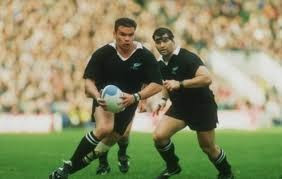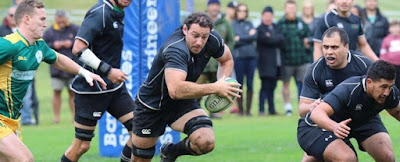The Ice Man - Part One
By Steve Hale
Having played the curtain raiser for Auckland Colts on Saturday the 14th of September 1985, Michael Jones sat back alongside team mates Zinzan Brooke and Bernie McCahill in the Lancaster Park stands, interested onlookers as their provincial A team lifted the log off Canterbury in a titanic struggle later billed ‘The Match of the Century’.
Within 24 hours the dynamic young loose forward had received a phone call from Auckland coach John Hart summoning him to join the senior team’s ranks. Three days later Michael Niko Jones made his first class debut, scoring a hat trick for Auckland against South Canterbury at Timaru. The Ice Man had arrived.
While Jones was not a complete rugby unknown, he had already represented New Zealand at U18 level and captained a fearsome Henderson High School 1st XV including Timo Tagaloa his subsequent progression through the ranks to the top level of the game was nonetheless was nothing short of incredible.
Within twelve months he had taken out a mortgage on the Auckland number eight jersey and made his test debut for Western Samoa fittingly against Wales at Apia. His father Derrick who passed away when Jones was just four years of age had taught in the Islands and was of Welsh heritage. Mother Maina was Samoan and remained a rock in her son’s life until a tragic accident while visiting Kenya in 1997.
Throughout the 1987 New Zealand Barbarians tour of the United Kingdom Jones began to unleash a complete skill repertoire. His left foot chip and chase try which completely befuddled veteran English fullback Dusty Hare. Future All Black team mates Alan Whetton and Mike Brewer could just shake their heads in disbelief. He was a complete package, a rugby agents dream.
Michael Jones was as close to the perfect prototype a rugby player will ever be. Tremendously strong and physical, a punishing defender, who could kick and pass or both feet and blessed with a sense of anticipation which ensured he was always on hand to take that last pass or make that bone jarring spot tackle.
A once in a lifetime player, his highlight reel remains so vivid even to this day, there was no need to dig out the annuals and cross reference any of his feats. He was the first player to score the opening try in two World Cups, not to mention being the first to dot down in the 1987 World Cup final.
On hand to clean up a botched Grant Fox snap shot Jones surged past legendary French fullback Serge Blanco to score. Veteran broadcaster Keith Quin immortalised the play with “There’s seven black shirts there…. Jones” which remained his signature line until the 1995 tournament when a young South Auckland behemoth ran roughshod over the hapless English defence.
I’m still to this day completely fixated by a piece of Jones magic which I observed from the Eden Park terraces as a rampant All Black side demolished the 1988 Welsh tourists. Jones showed the composure, skill and dexterity to scoop up a mistimed pass and roll the ball round his back while continuing at full speed towards the try line.
Jones played fifty-five test matches in in a career spanning thirteen seasons. He would undoubtedly have added many more internationals to that tally if it hadn’t been the fearful battering his body took in the name of All Black rugby.
His career will forever be marked by the horrific knee injury he suffered while trying to secure a loose ball against the Pumas against Athletic Park in 1989. Surgeons later likened the severity of the physical trauma to being in a collision with an oncoming vehicle travelling at 40 kilometres per hour.
Legend has it Jones spent the first night following his knee reconstruction without pain relief. The morning after his severed cruciate ligaments had been reattached, a Doctor enquired how Jones had managed his pain levels overnight.
Jones replied that he had pushed the button hanging by his bed as instructed several times and the intense discomfort soon dissipated. Upon closer inspection the Doctor couldn’t believe his eyes, the morphine pump had not been attached correctly. Throughout the entire night Jones mind had willed his body to overcome levels of pain which must have been close to intolerable.
It took thirteen months of intense rehabilitation before Jones was able to return to the playing field, fittingly marking his comeback with a try under the posts against Southland on Eden Park. A second knee reconstruction redefined his career. Losing much of his spring, footwork and athleticism Jones trained tirelessly, developing a Hulk like physique and switching to the blindside of the scrum. While his amazing ball skills and sense of anticipation remained, Jones completely overhauled his style of play, to become rugby’s version of the designated hitter.
One constant throughout Jones career however was his refusal to play on the Sabbath. All Black coaches Brian Lochore, John Hart and Grizz Wylie happily respected Jones beliefs even if it meant he was unavailable for several significant test matches during his career including the 1987 and 1991 World Cup Semi-finals.
Ultimately Jones stance did cost him selection in Laurie Mains 1995 World Cup Squad. Ironically the All Blacks sole loss in that tournament, the final, was played on a Saturday.
Jones bowed out of the game as a player in 1999 with a World Cup winner’s medal, back to back Super 12 titles and nine successful NPC campaigns to his name, proof that nice guys really can finish first.
Blog Originally Posted at http://www.insiderunning.com/OurBlog/tabid/189/EntryId/25/The-Ice-Man-Part-One.aspx






Comments
Post a Comment